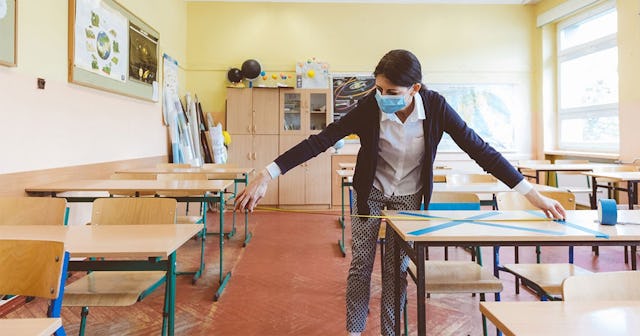AAP Release Guidelines On Schools Reopening This Fall

The American Academy of Pediatrics has released their recommendations for the 2020-2021 school year amid the COVID-19 pandemic
Summer vacation has just officially kicked off across the country. However, due to the lingering COVID-19 pandemic, the question on most parents’ mind is undoubtably the same: what is the 2020-2021 school going to look like? Following the CDC’s recommended guidelines for reopening schools, The American Academy of Pediatrics has update their interim guidance, COVID-19 Planning Considerations: Guidance for School Re-entry, on how schools and states should develop plans for reopening, giving us a glimpse into what they hope the upcoming school year will resemble.
The AAP explains that in-person lessons are critical to addressing racial and social inequity, and so they strongly encourage in-person schooling versus remote learning, but with stringent safety guidelines in place. “Evidence from spring 2020 school closures points to negative impacts on learning. Children and adolescents also have been placed at higher risk of morbidity and mortality from physical or sexual abuse, substance use, anxiety, depression, and suicidal ideation,” they explain in a press release accompanying their guidelines. “The AAP strongly advocates that all policy considerations for the coming school year should start with a goal of having students physically present in school.” However, they do offer “coordinated interventions” intended “to mitigate, not eliminate, risk” of SARS-CoV-2.
Many of their suggestions are similar to those of the CDC, and include cloth face coverings and masks, temperature checks, social distancing in classes, hallways, and on buses. They also recommend that students’ immunization requirements are up to date.
In the guidance, mask use and social distancing recommendations are made, taking into consideration factors such as students’ ages, developmental stages, and special considerations. “Evidence suggests that spacing as close as 3 feet may approach the benefits of 6 feet of space, particularly if students are wearing face coverings and are asymptomatic,” they explain. Schools should also weigh pros and cons of enforcing social distancing.
They also suggest other strategies by age. For example, for pre-kindergarten students, they suggest cohort classes, spending time outdoors, and limiting visitors to the building, due to the fact that it’s hard to implement social distancing at this age. Elementary students, on the other hand, should wear face coverings, desks should be spaced 3 to 6 feet apart, and both outdoor space and cohort classes are recommended. As for secondary school students (grades 6-12), they urge the importance of physical distancing, wearing face masks when closer than 6 feet apart, going outdoors when possible during activities like singing and exercise, and cohorting classes.
Other recommended distancing measures include assigned seating on buses by cohort, wearing masks on the bus, minimizing the number of riders on buses, and encouraging alternate transportation. In hallways, they suggest reducing congestion by implementing one-way hallways, rotating teachers instead of students, staggering class periods, and either eliminating lockers or assigning them by cohort. Students should also be divided up by cohort for meals, eating in their classrooms or outdoors when possible.
And, obviously, if a student has a fever or any other symptoms, they should stay home in order to potentially prevent spread.
Keep in mind that all of the guidelines set forth by the AAP are recommendations only, and it will be up to each state and local district to formulate their own reopening strategy. To read all of their recommendations, visit their website.